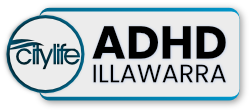RESOURCES
WHAT IS ADHD?
ADHD is a neurological disorder affecting the “wiring “in the brain. A child with ADD has “faulty” or “immature” wiring and therefore responds differently to children who do not have the condition. The condition is real and neither the parent nor the child is to blame for its existence. In his book, All About ADD, Mark Selikowitz[1] gives a detailed account of what constitutes the condition known as ADD. Table 1is an overview of the features of ADD as set out in his book.
Very few children exhibit every feature of ADHD however poor concentration, task impersistence and performance inconsistency will always be present. Other features in the table such as overactivity, disorganisation, learning difficulties etc. may or may not be present. ADHD affects at least 5-10% of school-age children. It was once thought children grew out of ADHD but recent research is changing our understanding of the disorder which persists into adulthood.
Features of ADHD[2]
The following features are always present: Poor concentration, task impersisitance and performance inconsistency.
The following may also be present: impulsivity, overactivity, social clumsiness, insatiability, disorganisation, inflexibility, learning difficulties, short term memory problems, low self-esteem and defiant behaviour.
Diagnosis
Diagnosis of ADHD is an important factor in helping the child. According to Wallace (1996)[3] the need for adequate and thorough diagnosis is absolutely critical. ADHD is a complex disorder and no two children will be exactly the same. In the past, this has often made it difficult to diagnose and to get appropriate treatment for the child. There is now a range of well-accepted and properly researched diagnostic tools available to doctors that enable them to give an appropriate and reliable diagnosis.
There is now evidence that most children carry the disorder into adulthood and an increasing amount of literature is becoming available.
Treatment of ADHD
There is no one right way of treating ADHD as each child is different and each treatment needs to be tailored to the child’s specific needs. Most professionals use a multi-modal approach and will adjust the treatment depending on the age and the progress of the child.
The multi-modal approach uses medication where it is deemed appropriate, provides parents with behavioural guidelines that work and parent management strategies that are relevant to the disorder. The multi modal approach also addresses such issues as training of other professionals in ADHD management (e.g. psychiatrists, psychologists, counsellors, social workers, teachers etc.), the role of the school in providing support, developing social skills in children and providing the child with any other skills that may be necessary to help them cope on a daily basis.
One of the major questions when ADHD is mentioned is that of medication. Do you or do you not medicate the child? This is something that each parent must decide for themselves. Health professionals will be able to guide you and help you to come to a decision that you are comfortable with.
Medication can be very useful in enabling the child to concentrate better, to learn at school, take responsibility for their behaviour and to develop appropriate social skills, but it is not the answer on its own. Its use is maximised when other strategies are also used in conjunction with medication.
For some children, medication is not appropriate and intensive behaviour modification in conjunction with other strategies is best used to help the child. In the end the choice is one that both the parent and the child are happy with and can maintain.

